How The Chemical Brothers Shows: Technical Details and Switching
Hi, Habr! I present to your attention the translation of an article on the internal structure of the show The Chemical Brothers.
Over the past 30 years, The Chemical Brothers have achieved international fame for all times. Their shows and technical equipment on stage are considered among the best. We went to a meeting with their staff specialist Matt Cox at the Creamfields festival in Liverpool in 2015 for a tour of the stage and the equipment used.
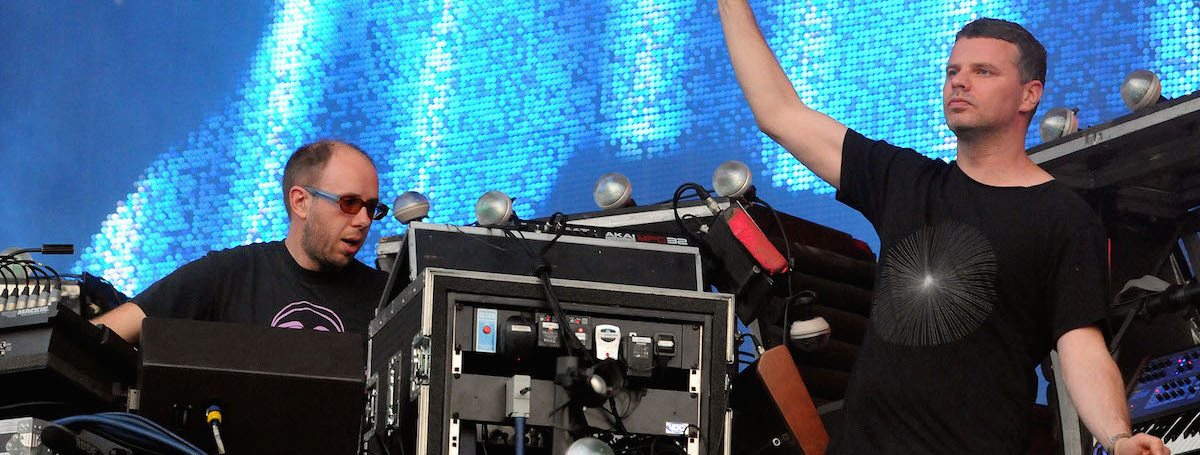
')
Matt was the designated backstage tech for The Brothers for many years. At that time, only the Akai MPC 3000 sampler and several hardware synthesizers were used. But with each new tour, the configuration evolved, and Matt’s responsibility was to ensure the performance of this impressive installation.
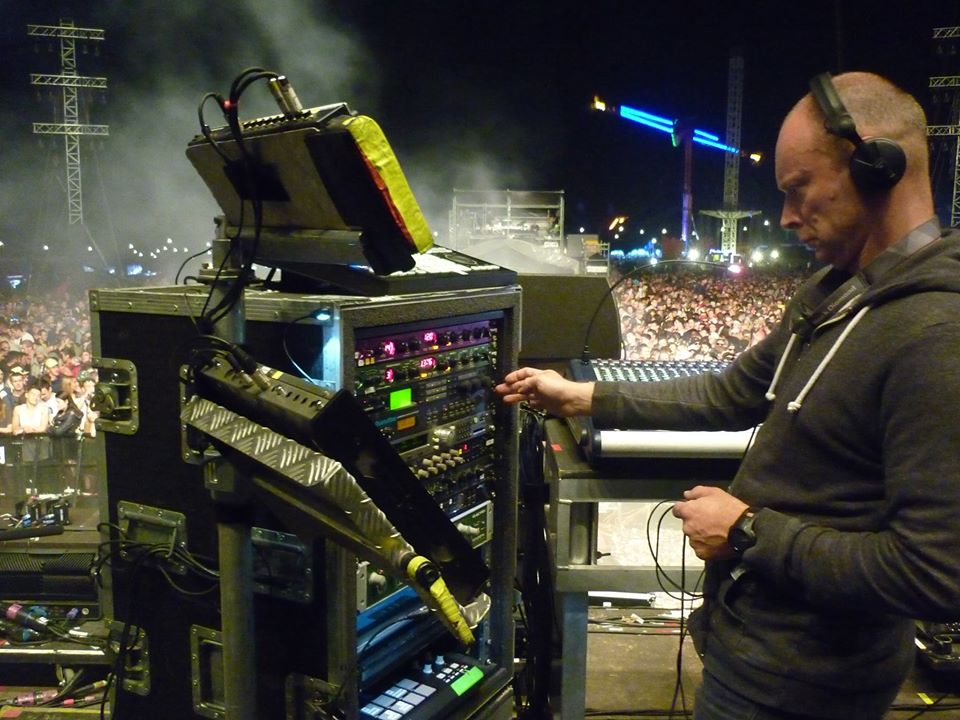
Matt Cox checks audio effect systems a few seconds before the show
Preparation of the new tour took 6 weeks. Matt first met Brothers in their studio to help prepare audio tracks for the main playback. He also began to assemble a rack with a playback system and equipment that the Brothers would use during the show.
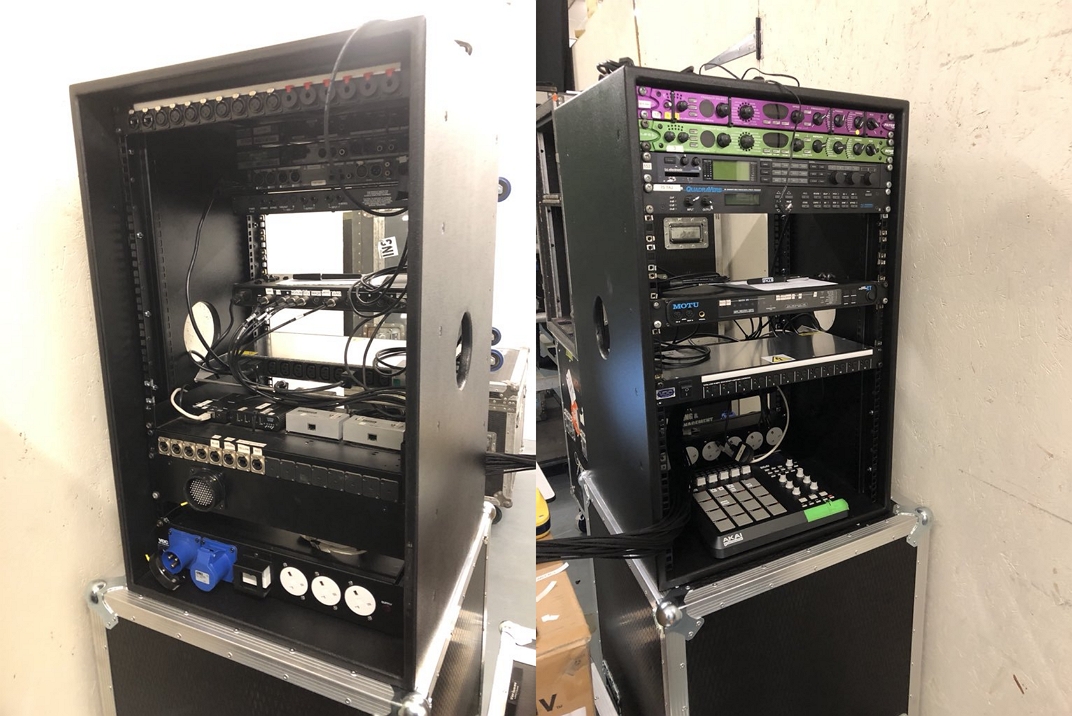
The initial stage of the assembly system audio effects
After 4 weeks, everyone gathered in a small studio to combine all the components, rehearse, and perform technical changes for flawless performance. Then everything is transferred to the large hall for building the stage and adjusting the synchronization of sound, light and two giant robots that appear at the end of the show.
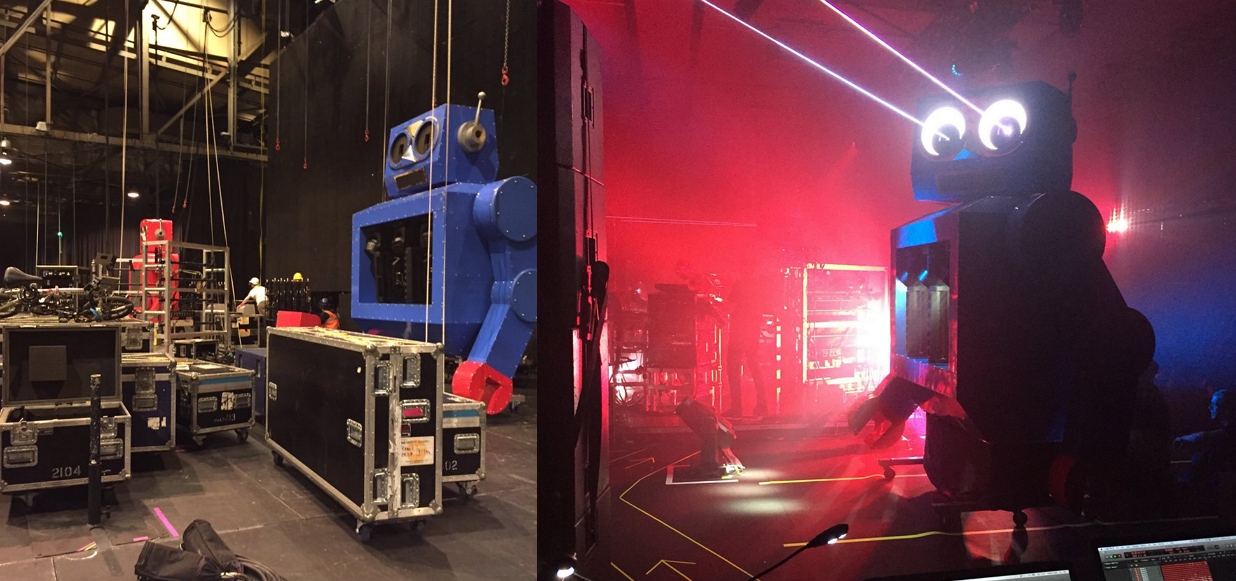
Robots George and Mildred - Mascots of The Chemical Brothers
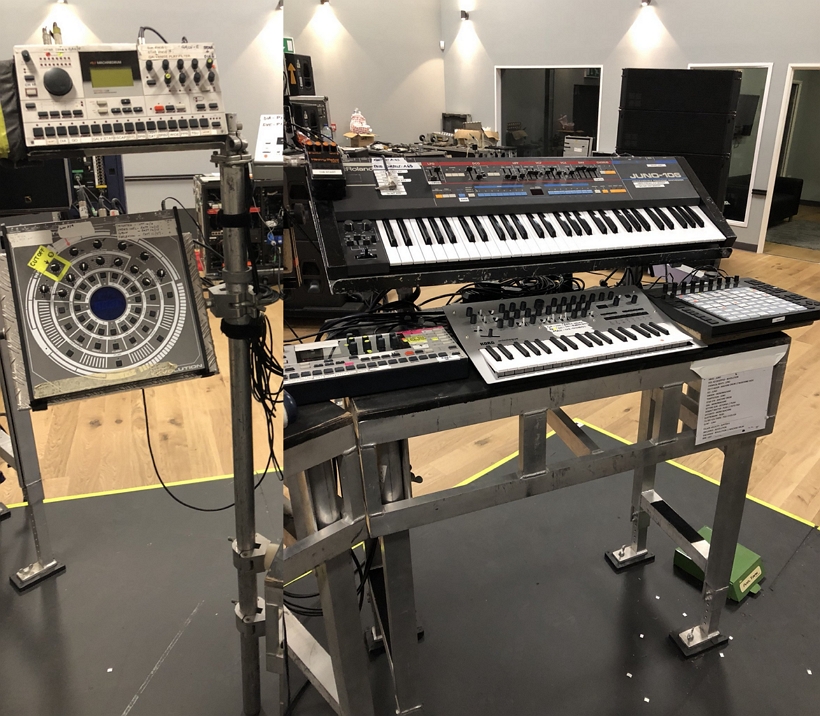
Equipment during rehearsals in a small studio
For the performance of the show, you need 3 racks filled with equipment, and 8 people traveling on 2 buses. When a team enters the scene, it works through all aspects of the show: sound, switching, light, and video. The festival team will only intervene in the release of giant robots, and that's all.
The performance is something between a DJ set and a live concert, because the tracks are connected at the beginning and at the end. The main substrates are prerecorded into audio tracks and played back from a Macbook Pro, while Brothers manipulate the textures of the synthesizers and reduce all sound sources on the console in real time.
This is a linear show in which the timeline starts at the beginning of the show and stops at the end.
The performance is based on a live mix of 25 audio signals thanks to the Soundcraft GB8 mixer. Most synthesizer and drum parts are pre-programmed, but some simple things are played live. The "patches" in the synthesizers are also preloaded, their "Brothers" switch in real time on the stage.

Soundcraft GB8 mixer - "heart" of the performance
Transitions between tracks are the main points of improvisation. The Brothers launch one-shot samples using an Ableton Push controller and use audio effects systems to fill the void spaces of the timeline.
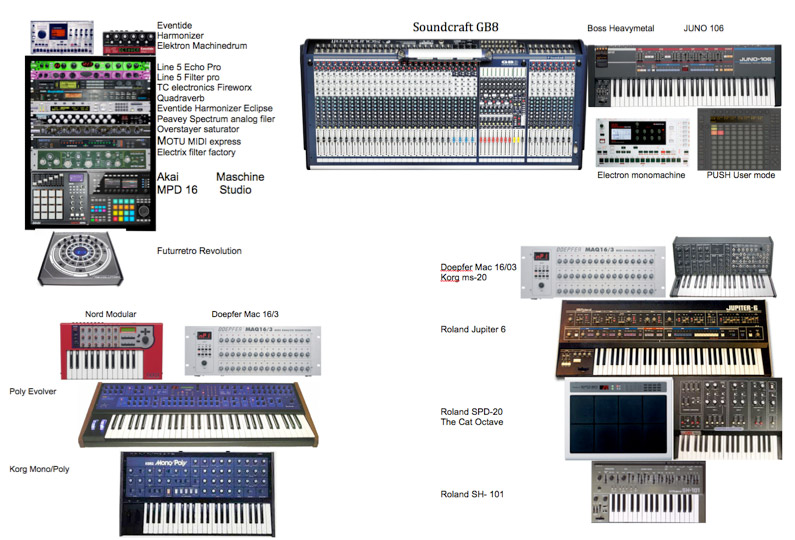
Used on stage equipment. In 2018, Korg Minilogue and Roland TB-03 were added to it.
Playback system:
After Matt has set up all the synthesizers, he sets the timeline to the beginning and remains at the computer to intervene if necessary. Logic Pro plays 13 pre-recorded audio tracks and sends a LTC (Linear Time Code) signal to the team responsible for the video. For the audio output are responsible interfaces MOTU 16A.
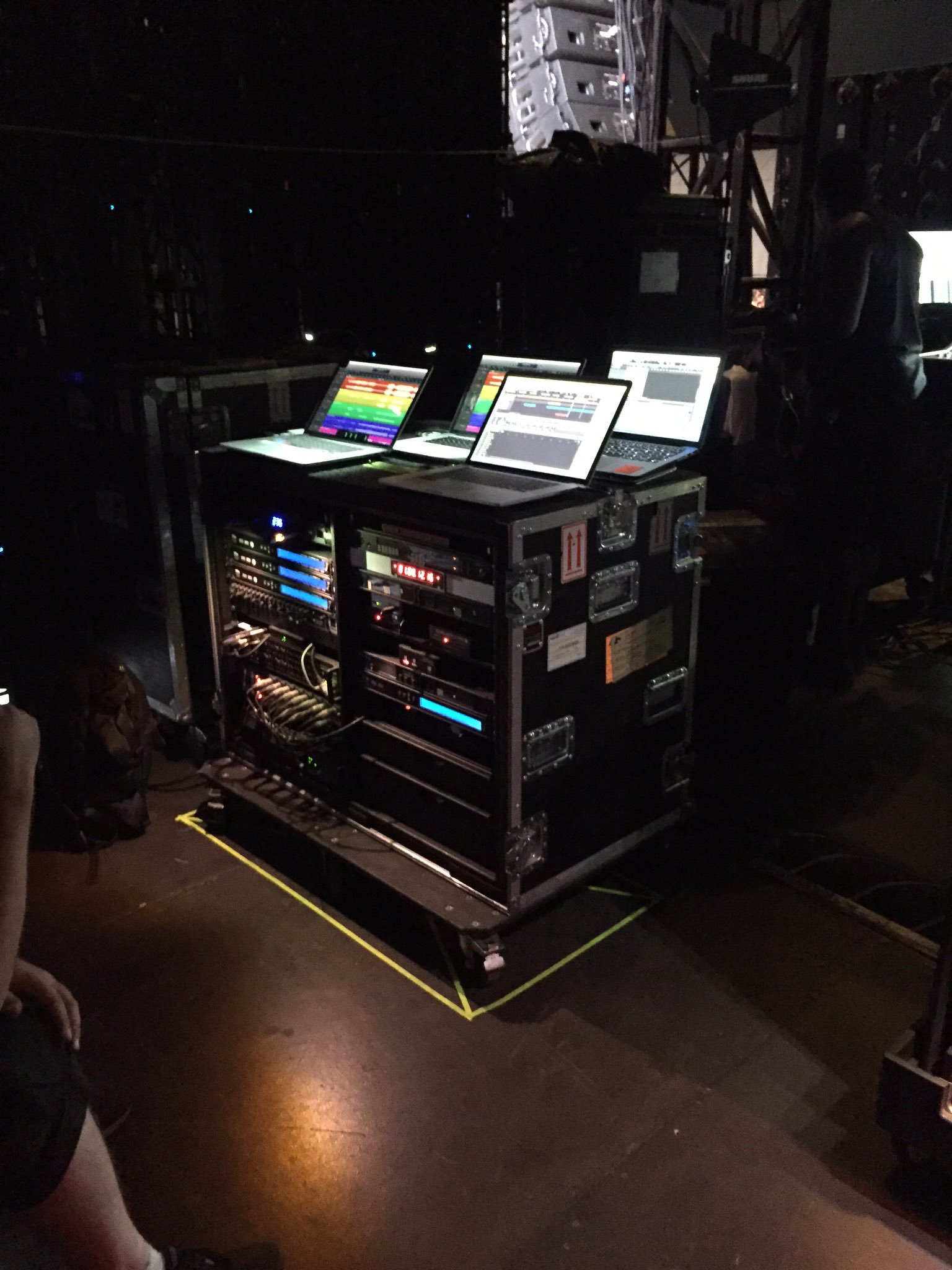
Offstage playback system: 2 x MacBook with Logic Pro X, 1 x MacBook with Ableton Live, 1 x MacBook with Avid ProTools

Two computers A and B play the same content at the same time, they are perfectly synchronized thanks to the MTC clock (MIDI Time Code), which is generated by the Rosendahl MIF4 module.

Rosendahl mif4 module
Thanks to this system, if the first computer with Logic Pro fails, the other can continue to work without problems. Even better: the first Logic Pro can then be restarted and synchronized with the same timeline as the second one. In addition, audio signals sent from two Logic Pro X instances go through the Radial SW8 switch, which constantly monitors the status of the signals, and switches the source in case of the first laptop falling.
Finally, the MTC is generated by the Sync-Gen II LE module for starting and synchronizing synthesizers and drum machines that surround the Brothers. These little boxes were designed to solve synchronization problems between software and hardware.
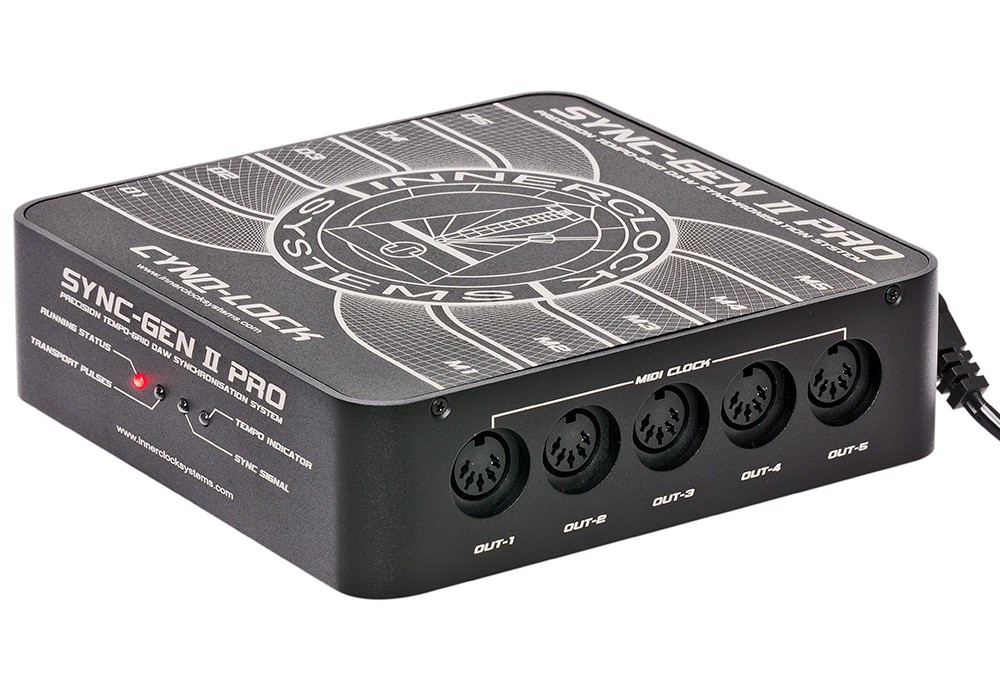
Sync-Gen II LE Module
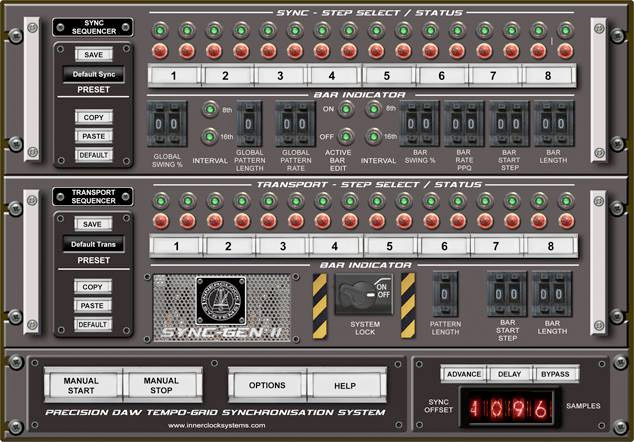
Plugin interface in Logic Pro
Instead of the classic USB or FireWire MIDI interface, the Sync-Gen II LE is a plugin that generates a pulse signal to an external unit, which then generates a MIDI clock. Pulse and traditional audio signals are combined in this device, providing stable lossless synchronization. The MIDI signal is then sent to Kenton LNDR MIDI, for transport via the Ethernet cable to the stage. On the receiving side, MOTU MIDI Patchbay is used, which distributes the signals to all other equipment.
Synthesizers are pretty vintage and prone to errors by nature. They can be out of sync at any time. Matt created an iPad app to conveniently restart the MTC signal during the show. At the right moment (when the drum parts are not playing), he can re-synchronize all the machines at the critical point.
The third laptop is equipped with Ableton Live and is used as a sampler, and also interacts with the NI Maschine plugin. All vocals play in Ableton as an audio track. Some drum scenes are triggered by “Brothers” from the Maschine Studio controller, “one shot” samples are launched from the Ableton Push controller as a Drum Rack tool. For interaction between USB MIDI controllers between the scene and the backstage, Black Box USB extensions are used.
The fourth computer launches Pro Tools to record each show, including microphones, to capture the sound of the crowd.

Sound Engineer at the MIDAS Legend 3000 Remote Control
Two sound engineers travel with the team. One of them is responsible for the sound from the main console (Front Of The House, FOH), the other monitors the sound on the stage. They are very active during the performance, they regulate the levels and frequency peaks sent from the console to the stage. They also apply real-time compression to get a solid organic mix. MIDAS mixers also go beyond their capabilities to get an even warmer sound.
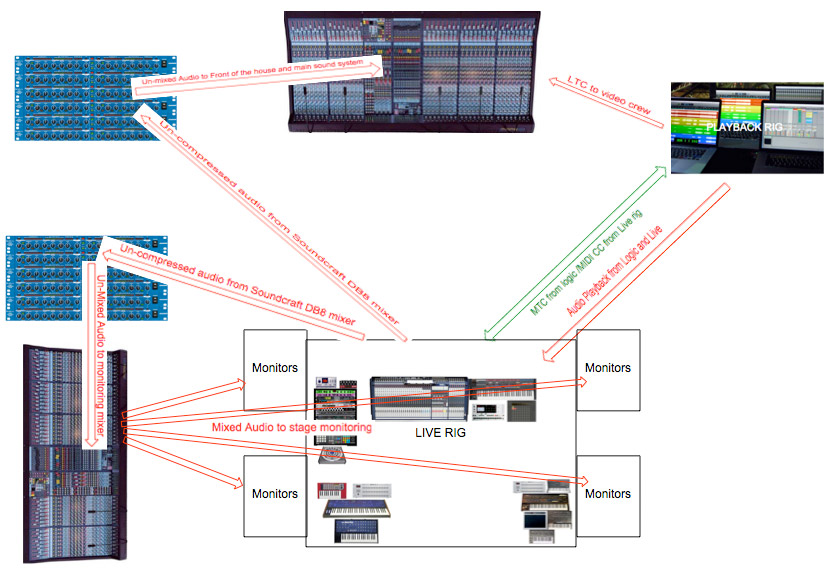
Signal flow chart
Matt Cox's Twitter (source of some photos)
Over the past 30 years, The Chemical Brothers have achieved international fame for all times. Their shows and technical equipment on stage are considered among the best. We went to a meeting with their staff specialist Matt Cox at the Creamfields festival in Liverpool in 2015 for a tour of the stage and the equipment used.

')
Matt was the designated backstage tech for The Brothers for many years. At that time, only the Akai MPC 3000 sampler and several hardware synthesizers were used. But with each new tour, the configuration evolved, and Matt’s responsibility was to ensure the performance of this impressive installation.

Matt Cox checks audio effect systems a few seconds before the show
Preparation of the new tour took 6 weeks. Matt first met Brothers in their studio to help prepare audio tracks for the main playback. He also began to assemble a rack with a playback system and equipment that the Brothers would use during the show.

The initial stage of the assembly system audio effects
After 4 weeks, everyone gathered in a small studio to combine all the components, rehearse, and perform technical changes for flawless performance. Then everything is transferred to the large hall for building the stage and adjusting the synchronization of sound, light and two giant robots that appear at the end of the show.

Robots George and Mildred - Mascots of The Chemical Brothers

Equipment during rehearsals in a small studio
For the performance of the show, you need 3 racks filled with equipment, and 8 people traveling on 2 buses. When a team enters the scene, it works through all aspects of the show: sound, switching, light, and video. The festival team will only intervene in the release of giant robots, and that's all.
The performance is something between a DJ set and a live concert, because the tracks are connected at the beginning and at the end. The main substrates are prerecorded into audio tracks and played back from a Macbook Pro, while Brothers manipulate the textures of the synthesizers and reduce all sound sources on the console in real time.
This is a linear show in which the timeline starts at the beginning of the show and stops at the end.
The performance is based on a live mix of 25 audio signals thanks to the Soundcraft GB8 mixer. Most synthesizer and drum parts are pre-programmed, but some simple things are played live. The "patches" in the synthesizers are also preloaded, their "Brothers" switch in real time on the stage.

Soundcraft GB8 mixer - "heart" of the performance
Transitions between tracks are the main points of improvisation. The Brothers launch one-shot samples using an Ableton Push controller and use audio effects systems to fill the void spaces of the timeline.

Used on stage equipment. In 2018, Korg Minilogue and Roland TB-03 were added to it.
Playback system:
After Matt has set up all the synthesizers, he sets the timeline to the beginning and remains at the computer to intervene if necessary. Logic Pro plays 13 pre-recorded audio tracks and sends a LTC (Linear Time Code) signal to the team responsible for the video. For the audio output are responsible interfaces MOTU 16A.

Offstage playback system: 2 x MacBook with Logic Pro X, 1 x MacBook with Ableton Live, 1 x MacBook with Avid ProTools

Two computers A and B play the same content at the same time, they are perfectly synchronized thanks to the MTC clock (MIDI Time Code), which is generated by the Rosendahl MIF4 module.

Rosendahl mif4 module
Thanks to this system, if the first computer with Logic Pro fails, the other can continue to work without problems. Even better: the first Logic Pro can then be restarted and synchronized with the same timeline as the second one. In addition, audio signals sent from two Logic Pro X instances go through the Radial SW8 switch, which constantly monitors the status of the signals, and switches the source in case of the first laptop falling.
Finally, the MTC is generated by the Sync-Gen II LE module for starting and synchronizing synthesizers and drum machines that surround the Brothers. These little boxes were designed to solve synchronization problems between software and hardware.

Sync-Gen II LE Module

Plugin interface in Logic Pro
Instead of the classic USB or FireWire MIDI interface, the Sync-Gen II LE is a plugin that generates a pulse signal to an external unit, which then generates a MIDI clock. Pulse and traditional audio signals are combined in this device, providing stable lossless synchronization. The MIDI signal is then sent to Kenton LNDR MIDI, for transport via the Ethernet cable to the stage. On the receiving side, MOTU MIDI Patchbay is used, which distributes the signals to all other equipment.
Synthesizers are pretty vintage and prone to errors by nature. They can be out of sync at any time. Matt created an iPad app to conveniently restart the MTC signal during the show. At the right moment (when the drum parts are not playing), he can re-synchronize all the machines at the critical point.
The third laptop is equipped with Ableton Live and is used as a sampler, and also interacts with the NI Maschine plugin. All vocals play in Ableton as an audio track. Some drum scenes are triggered by “Brothers” from the Maschine Studio controller, “one shot” samples are launched from the Ableton Push controller as a Drum Rack tool. For interaction between USB MIDI controllers between the scene and the backstage, Black Box USB extensions are used.
The fourth computer launches Pro Tools to record each show, including microphones, to capture the sound of the crowd.

Sound Engineer at the MIDAS Legend 3000 Remote Control
Two sound engineers travel with the team. One of them is responsible for the sound from the main console (Front Of The House, FOH), the other monitors the sound on the stage. They are very active during the performance, they regulate the levels and frequency peaks sent from the console to the stage. They also apply real-time compression to get a solid organic mix. MIDAS mixers also go beyond their capabilities to get an even warmer sound.

Signal flow chart
Matt Cox's Twitter (source of some photos)
Source: https://habr.com/ru/post/425305/
All Articles